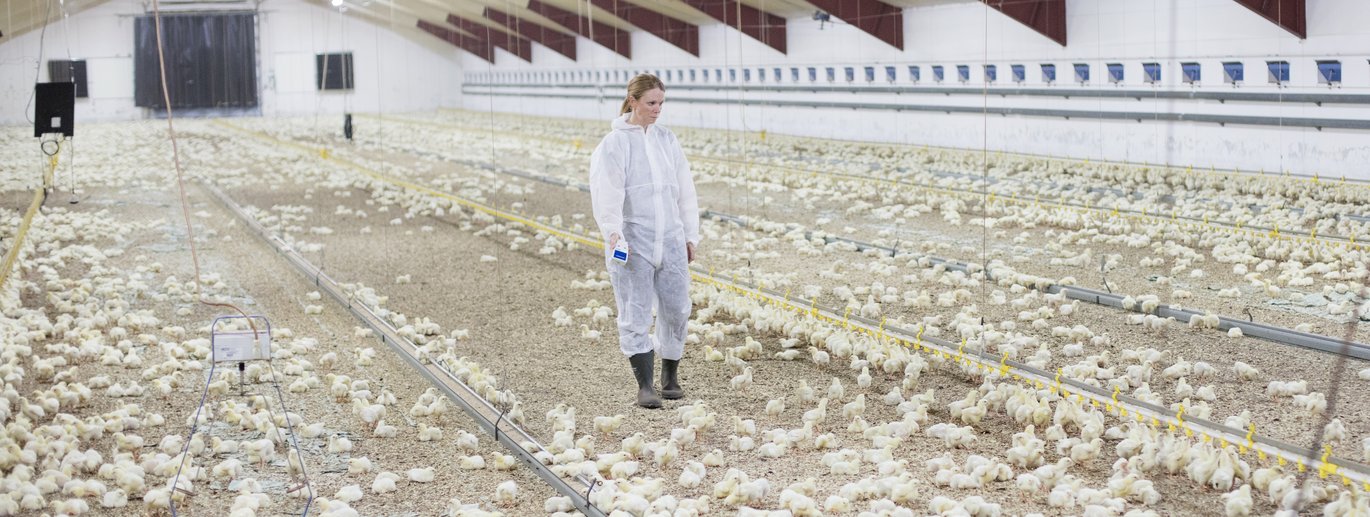New tool for monitoring bacteria and viruses in poultry stables
There are many indications that monitoring and testing of the presence of Campylobacter and Salmonella in poultry flocks will be easier in the future. A new air-based sampling method makes it easier and faster than current practice to test for bacteria and viruses in poultry stables.

Campylobacter and Salmonella are significant zoonotic pathogens, which are the cause of the majority of food borne diarrhoea diseases in humans all over the world. In Denmark, the risk of Salmonella infections associated with the consumption of meat from slaughter poultry and eggs has fallen drastically due to a national action plan, which involves ongoing monitoring of Salmonella in meat and egg production throughout the production period and at slaughter. On the other hand, the occurrence of Campylobacter is still frequent in Danish slaughter chicken production, where approx. 22% of poultry flocks are tested positive for Campylobacter at slaughter.
At the moment, monitoring of Salmonella and Campylobacter is taking place at the broiler producer by collecting litter samples during stable rounds using sampling material on clean footwear (sock samples). This makes it possible to detect these pathogens on basis of subsequent cultivation in the laboratory. The status of the poultry flock is therefore not known until after slaughter. Fast and reliable tests for zoonotic pathogens in the stables during the production period are, however, crucial to make it possible to implement measures that prevent the spread of bacteria during the slaughter process.
New test tool tested in practice
A new test tool, AeroCollect® for monitoring and testing of the presence of Campylobacter and Salmonella has therefore been tested in two Danish slaughter poultry flocks. The study was carried out in collaboration between FORCE Technology and Aarhus University. The AeroCollect® tool collects air samples in which both bacteria and viruses can be identified quickly in poultry stables.
"In this study, we compared the AeroCollect® tool with the traditional sock samples, which are used for monitoring and detecting of Campylobacter and Salmonella" says Associate Professor Ricarda M. Engberg from Aarhus University, Department of Animal and Veterinary Sciences, who participated in the study, which was divided into the following two studies:
- The study of Campylobacter was based on paired samples collected on a weekly basis from 12 rotations in two poultry flocks with known Campylobacter infection history.
- The study of Salmonella was based on a controlled infection experiment in which chickens were infected orally with Salmonella Typhimurium at the age of 15 days.
The collected air samples were analysed using traditional PCR and RT-PCR methods.
Fast and reliable tool for flock-based diagnostics
The results from the two studies show that the AeroCollect® system is a fast and reliable tool for flock-based diagnostics and screening for Campylobacter and Salmonella, which can easily be used in the production period.
In the flocks that were naturally infected with Campylobacter, it was noticed that the air samples were positive at the same time or slightly before the corresponding sock samples. In flocks artificially infected with Salmonella, where all chickens were infected orally at the same time, the sock samples were positive slightly earlier than the corresponding air samples. "In the future, it will be beneficial to investigate whether this also applies for naturally infected Salmonella-positive flocks," says Ricarda M. Engberg.
The air samples contain enough test material for several tests, and as the collection procedure for Campylobacter and Salmonella is the same, a single sample can be used to examine the flocks for both pathogens.
The new tool is already being widely used. The technology has been routinely implemented at several companies in the poultry industry in the Nordic countries (primarily detection of viral diseases) as well as worldwide (detection of viral diseases and to a great extent monitoring of Salmonella and other bacterial pathogens).
| Supplementary information | |
| We strive to ensure that all of our articles comply with Universities Denmark’s principles for good research communication. Therefore, we have supplemented the article with the following information: | |
Funding | Force Technology |
Collaborators | Karsten Brandt Andersen M.Sc.Eng., PhD, Force Technology
|
External comments | Karsten Brandt Andersen, AeroCollect A/S (formerly Force Technology). |
Learn more | K. B. Andersen R. M. Engberg and J. Skov 2022: A new tool for air sample-based surveillance of Campylobacter and Salmonella in poultry flocks. J. Appl. Poult. Res. 31:100236 https://doi.org/10.1016/j.japr.2022.100236 |
Contact | Ricarda M. Engberg,
|
